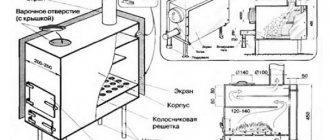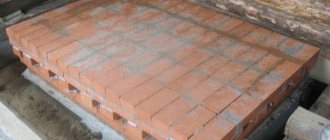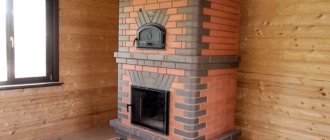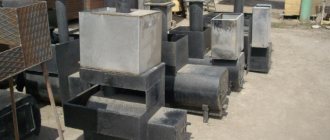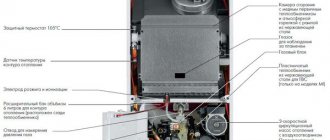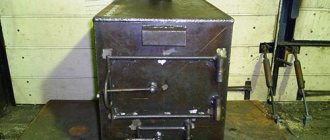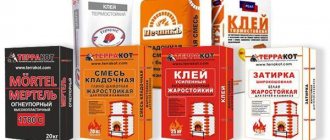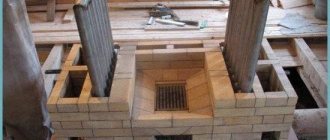The waste-free nature and low cost of gas make it very attractive for owners of private houses and summer cottages.
Where this fuel is freely available, not only kitchen stoves, but also home and bathhouse heating are switched to it. Factory models are made of cast iron or steel, beautiful and safe.
They cost about 10 – 30 thousand rubles. But some designs are delivered disassembled, forcing the buyer to pick up the tool and assemble it by hand.
Other craftsmen make the device completely independently.
What a gas stove for a sauna should look like with your own hands. What will be needed for production and will it be profitable?
Design
The basis of any gas oven is the gas burner. It supplies fuel, which is ignited. In most cases, a closed heater is located above the burner. A water supply gutter is connected to the heater. Steam and moisture from this compartment must be completely isolated from the fuel combustion area.
At the bottom of the housing there is an inlet for supply air, which is necessary for the combustion process. Thus, gas ovens also have their own “blower”.
It is known that the convector heating principle is one of the most effective. Slots are made in the body of gas furnaces - slits that allow air heated inside the furnace to escape. This greatly increases the rate of heating of the room.
Building a sauna stove is a responsible matter, but installing a stove in a bathhouse with your own hands is even more responsible, because people’s safety depends on it. The installation rules and procedures are described in this article.
The technology for making an electric boiler with your own hands is described here.
Brick stoves in bathhouses are less common than metal ones, since the former are quite difficult to build, but brick construction has more advantages. It is more durable and productive. In this topic you will find instructions for making a brick sauna stove with your own hands.
Design features
Craftsmen have come up with homemade designs for gas stoves for baths, but without experience, it is difficult to make a gas burner with your own hands. Models from well-known manufacturers meet all fire safety requirements, and you can install them correctly yourself. The main thing is to coordinate the project with the gas and fire authorities of the city.
Gas heat generators are divided into types according to their purpose:
- Household.
- Heating.
- Heating.
Heating generators are used in bath structures. In rare cases, heating systems are additionally used, for example a gas boiler, when it is necessary to provide heating and hot water supply in the bathhouse. It is impossible to heat a bathhouse with their help.
Household appliances include appliances, for example, for cooking. They are simple to maintain, which is why you can often find something like a gas stove in a dacha. But maintaining a high temperature in a room with humidity above normal can only be done with heating.
Based on their design features, gas furnaces are divided according to the following criteria:
- Burner design.
- Methods of heating water.
- What material was used for manufacturing.
- Type of fuel.
Take a closer look at some of them.
When supplying gas to the bathhouse, you must not forget about possible leaks. Therefore, there are special requirements for bath equipment:
- A special sensor must be installed in the stove, which will prevent the supply of gas if the burner goes out.
- Natural gas is supplied through the city main pipe; cylinders are filled with propane and buton at simple gas stations.
- When installing gas stoves, it is necessary to comply with all fire safety rules, as when heating with wood or liquid fuel.
- In the bathhouse, it is necessary to properly install the exhaust system and chimney.
A gas furnace is structurally identical in many respects to a conventional boiler, but differs in quality characteristics associated with the characteristics of the gas. Thus, a fuse is necessarily provided in the housing, which stops the fuel supply when the burner goes out, creating an absolutely sealed gas chamber. But the fundamental difference lies in the fuel supply - if in a solid fuel stove the fuel is loaded into the chamber, then in a gas stove it comes directly from the gas pipeline.
Photo 2 Design features of a gas furnace
For maximum safe operation, gas cylinders are always placed outside the building in a special container or bunker placed underground.
The main indicator on which the calculation depends is the area of the room and the power consumption of the equipment. Outdoor temperature readings taken during the coldest time are also taken into account.
The calculated figure is ideally always 35-50% higher than actually consumed, since the air temperature always changes up or down. When choosing ready-made equipment, this fact should be taken into account and instead of, for example, 100 W of energy, you can take 50.
The amount of natural gas is calculated using the formula:
- L – calculated volume of fuel (1 cubic meter per hour);
- Q – heating power, kW;
- qН – maximum fuel combustion power, for natural gas 10.175 kW/m 3 ;
- 0.92 – efficiency of a gas boiler/furnace.
5 / (10.175 x 0.92) = 0.53 m 3 / h,
which corresponds to the consumption of natural gas per unit of time (hour).
Based on such indicators, it is possible to determine the nominal gas consumption in any room for a certain period of time. Since the bathhouse is not used daily or around the clock, this consumption will be less.
5 / (12.8 x 0.92) = 0.42 kg/h,
which corresponds to 0.78 liters per hour. Considering that 1 liter of bottled gas weighs 540 mg. Based on the approximate number of days and hours of operation of the bath, you can calculate the required volume.
In order to make a stove for a gas bath with your own hands, you need to decide on three main parameters:
- Material;
- What kind of gas burner will it be?
- Placement of the container – built-in or remote tank.
Now about each of them in more detail.
As mentioned earlier, to make a stove for a gas bath with your own hands, it is recommended to use fireclay (fireproof) brick, metal or stone. Stone stoves take much longer to heat up (4-5 hours), but the temperature is maintained 3-4 hours longer than metal stoves. Brick ones are characterized by similar indicators. In turn, metal units heat up faster (rooms up to 50 sq.m. completely warm up in 2.5-3 hours), but also cool faster.
At the same time, metal stoves are lighter than their brick counterparts and are easier to manufacture, and if the outside is lined with fireclay bricks, then there will be no fundamental difference between the 2 units.
Gas-burners
There are 2 main types of burners - atmospheric and pressurized.
The first option is the simplest, which does not require automatic control and related equipment. With such an atmospheric atmosphere, the intensity of the fire is maintained by the air entering the chamber through the doors; accordingly, the heating efficiency directly depends on the amount of incoming air.
Photo 3 Atmospheric burner
The operation of the inflatable burner is ensured by a blower fan, which forces air into the chamber and also supports the operation of the burner. Considering that the fan operates from the mains, the heating unit is energy dependent, which means it is more expensive.
Photo 4 Inflatable burner
A similar fan is installed in solid fuel, combined and pyrolysis boilers. You will learn how to make a pyrolysis boiler with your own hands in the corresponding article.
By analogy with traditional sauna stoves using gas equipment, the water tank can be built-in, removable or remote, that is, located in another room. In the built-in one, water heats up much faster, which is facilitated by combustion products in the heater.
We invite you to familiarize yourself with bathhouse furniture for a bathhouse with your own hands drawings
Photo 5 Location of the water tank
To heat water in a remote tank, which can be installed in the same room or directly in the steam room, a pipe system is used.
The device is adapted for natural gas fires; steam is released when water is directly supplied to a closed heater with an average temperature of 600 °C. Available in two versions: with walls made of structural or chrome-plated steel, the design hides the gas burner. Recommended for use in Russian steam baths with a volume of 6–18 m3, the steam produced is light.
A clever meter that saves electricity Pays for itself in 2 months!
2. Urengoy Inox, Termofor.
A model with a deep and capacious heater, heating is carried out in 4 directions, the steam quality is high. The recommended sauna mode is Finnish; thanks to the built-in shielding convector, the firebox produces soft heat. The combustion elements of the gas furnace are designed to withstand frequent thermal loads: they are made of high-alloy steel, the wall thickness is 3 mm. Two modifications are available: Anthracite and Terracotta, the door is made of tinted glass, all communications and pipes are hidden.
3. Standard G-2.0, Kutkin.
Refers to multifunctional gas stoves: operation in Turkish, Finnish and Russian bath mode. The generated thermal power with the small dimensions of the device itself allows you to warm up a steam room up to 25 m3 well and quickly; there are also more economical modifications - up to 18 m3. These gas furnaces are made to order, since the manufacturer produces mainly combined ones.
But the demand for Standard G-2.0 is stable, reviews indicate the reliability of the model at an affordable price. An additional advantage is the ability to choose cladding: soapstone, coil or jadeite. The appearance of these gas sauna stoves is very noble, they are suitable for any type of interior.
4. Kusatherm, Kusatek.
A compact device with a unique design: thanks to the presence of a fan, combustion products are removed through the walls, and not through a vertical chimney; heating occurs inside a spiral pipeline made of refractory steel. This allows you to install a gas stove in the middle of the steam room, surround it on all sides with stones, place it around a bench, or use any design option.
The model range is represented by units with thermal power from 10 to 90 kW, which is suitable for rooms with a large volume of heated air, while fuel consumption is half as much as in comparison with domestic analogues. The package includes thermal insulation of the floor and is equipped with a reliable automatic control system with a digital panel.
The fan and burner are located outside the heated room, the device is absolutely safe; when the pressure in the line drops, its operation stops. Kusatek has no design flaws; the only limitation in use is the price, which is ten times higher in power than domestic analogues.
5. KomPAR 50, Teplodar.
This option is well suited for commercial baths; the device heats steam rooms with a volume of up to 70 m3. Refers to gas sauna stoves with high efficiency, the temperature of the flue gases is not higher than 200 °C, the heat is evenly distributed not only in the firebox area, but also in a complex system of smoke exhaust pipes.
This allows you to heat up to 300 kg of stones to the required state, which means the rapid formation of light steam in the required volume and long-term support of a comfortable microclimate. Recommended gas burners for use: Ferolli Sun M6, Weishaupt WG5, Lamborghini EM 6-E.D1 with one- and two-stage operating modes, power reaches 100 kW.
Materials for a gas sauna stove
According to manufacturing materials:
- Cast iron.
- Steel.
- Brick.
Cast iron structures are not available for independent reproduction, since they are cast on industrial equipment.
Steel stoves are compact and lightweight. They do not require a massive foundation. The thickness of the metal is about 5 mm. Their walls can become very hot, so usually a protective “casing”, for example, made of brick, is built on several sides of the stove. A sauna equipped with a metal stove warms up in 2–3 hours.
You can also build a hybrid of a brick oven and a gas burner with your own hands. Such a unit will take longer to melt, but it will also retain heat in the room longer.
When deciding whether to build a brick oven, you need to consider:
- There are metal structures inside the array, so welding work cannot be avoided.
- Brickwork is a labor-intensive and time-consuming process that requires special skills.
- The structure will require more space.
- As a base, you will need a concrete slab that is not connected to the foundation of the bathhouse.
- The brick oven needs to be heated 5 – 6 hours before the start of the bath procedures.
- The heat from a brick oven is softer, the masonry does not heat up and does not pose a threat to people and the walls of the building.
Some craftsmen even manage to remake a finished brick wood-burning stove by inserting a burner into it. But you need to remember that a brick is a heat accumulator that is not capable of so quickly absorbing the amount of heat that the burner provides.
Brick oven
Therefore, massive stoves (Russian) and bell-type stoves are not suitable for conversion. You can gasify a Swedish, Dutch and other models with several wells.
The main disadvantage of metal sauna stoves is that they cool down quickly. Therefore, owners of solid fuel stoves are forced to constantly “add” fuel during bathing procedures. For gas stoves this is not a problem. They simply remain “on” all the time while people are in the bathhouse.
Preparation for construction
Image 1. Furnace installation location.
First, decide on the location of the sauna stove. Usually the stove is installed near a partition or wall, because its task is to heat the steam room and maintain the desired temperature in the relaxation room.
Furnace installation location - image 1.
When constructing a furnace, it is advisable to use only high-quality materials. To make a sauna stove with your own hands, prepare the following materials and tools:
- heat-resistant brick;
- clay, sand, crushed stone;
- galvanized sheet;
- fittings;
- metal and asbestos-cement pipes;
- grate;
- blower and combustion doors;
- water and gas pipe;
- steel sheet;
- kneading container;
- hacksaw for metal;
- welding machine;
- knife;
- pick;
- screwdriver.
We invite you to familiarize yourself with the base for tiles on a wooden floor
First make the base. Dig a hole, its bottom should be below the freezing level of the soil, this is about 70 cm. Make the bottom of the hole slightly wider than the main hole. Place sand at the bottom in a layer of 15 cm. Spray the sand base with water, compact it, and place a layer of stone on top interspersed with pieces of brick about 20 cm.
Then pour crushed stone, make formwork and install a reinforced frame. Pour the concrete, when it hardens, disassemble the formwork, and lay tar on top in a couple of layers. Fill the place where the boards were with a gravel-sand mixture. Place waterproofing material at the top of the foundation.
Burner selection
Burners are:
- Atmospheric.
- Supercharged.
For a homemade design, you can only use forced-air burners. They are more complex than atmospheric ones, but much safer.
The devices are equipped with automatic valves that will shut off the gas if the flame goes out, or the stove overheats, or if there is a leak. There are models with automatic ignition.
You need to purchase a burner in advance, before stocking up on all the materials. The fact is that burners come in different sizes and shapes - drawings and diagrams will be developed based on this.
Metal is a material that is easy to process. You can make a do-it-yourself sauna stove from metal very quickly, and the design will be mobile.
For models of long-burning stoves for the home, see this review.
Video
We invite you to watch videos about some models of such stoves.
An interesting Salekhard stove, designed specifically to operate on gas, unlike other stoves that are designed to operate on wood and are equipped with burners.
Another review of the stove from Izistim. A separate article is devoted to the Yalta 25 stove.
And here is the opinion of a specialist from the bath association.
***
Here is a brief overview of the most significant issues related to a gas sauna stove. More information, as already mentioned, can be found in our other article.
Information about wood-burning and electric stoves is collected in separate publications. Obtaining complete information about the types of units will allow you to decide which sauna stove is better.
Methods of heating water
To heat water, you can build a classic container - a tank. It can be located directly above the heater, or near the walls. Or it can be “put on” a chimney pipe (the latter option is preferable, since the stove itself is simpler and lighter, and the heat is consumed as efficiently as possible).
Another option is to place the tank in another room and make a heat exchanger inside the boiler. The liquid, passing through a system of thin tubes inside the oven, heats up and comes out hot. This allows you to separate the steam compartment with the oven, from the washing room with the hot water tank.
Each steam room has its own stove!
When choosing a stove for a sauna that runs on gas, as in other cases, one is guided by power characteristics. First, the area of the steam room is calculated so that it is clear which model you need to purchase. It is also important to decide on the variation of the control unit, which is almost always purchased separately. Few models on the market come with built-in control systems. Advice from specialists and sales managers will help you decide.
Some gas sauna stoves come with built-in water tanks. It is very comfortable. When planning to purchase such a device, you don’t have to worry about the location of hot water storage tanks. At the same time, experts advise purchasing devices with a tank located on the pipe. They are practical and do not take up much space.
There are differences in the degree of functionality. Some models run on natural gas, others on liquefied gas. There are devices with combined action. When purchasing models that operate on all types of fuel, check the availability of circuit injectors and their mounting options.
Inspect the oven layout. The kit may include a chimney deflector. If not, then be sure to purchase the device. Manufacturers always supply with combined models spare adapters and couplings necessary for installing and changing nozzles. If they are not included in the kit, purchase devices in advance that are adaptive specifically to your gas stove model.
Do-it-yourself gas stove for baths
What you need to prepare to build a gas sauna stove:
- Atmospheric burner.
- A gas cylinder (not old), or a pipe with a diameter of 50 - 60 cm, or metal 8 - 16 mm thick.
- The base of the heater can be made from a car brake disc; very thick metal will not burn out for a long time.
- Two gas pipes of 50 mm diameter.
- Pipe 100 mm in diameter for gas removal.
- Copper or bronze connecting elements.
- Tools (welding machine, grinder, drill, plumbing, measuring tools, etc.)
The edge of the cylinder is cut so that the cut diameter matches the external size of the brake disc. The disk is attached using welding or bolts.
Gas furnace device
A pipe is made that will supply air to the combustion chamber. Several holes (about 10 pieces) are drilled into the pipe section, after which a place is prepared for it in the lower part of the furnace body. The hole in the housing should be slightly larger than the diameter of the tube. It is welded so that the edge without holes protrudes outward from the cylinder by about 20 cm.
Everything needs to be done especially carefully when working with the pipe that will supply gas. An adapter is installed at one end, connecting the pipe to the gas source, and the second is welded into the furnace next to the air pipe.
Further steps are exactly the same as when making a regular boiler. A chimney pipe is welded into the upper part of the cylinder (it must be solid, without seams).
At the owner's request, legs can be installed. Fill the heater.
Getting steam from a gas heater is more difficult than from a wood-burning one. It takes longer to heat it, and you need to choose stones more carefully, with good heat capacity.

